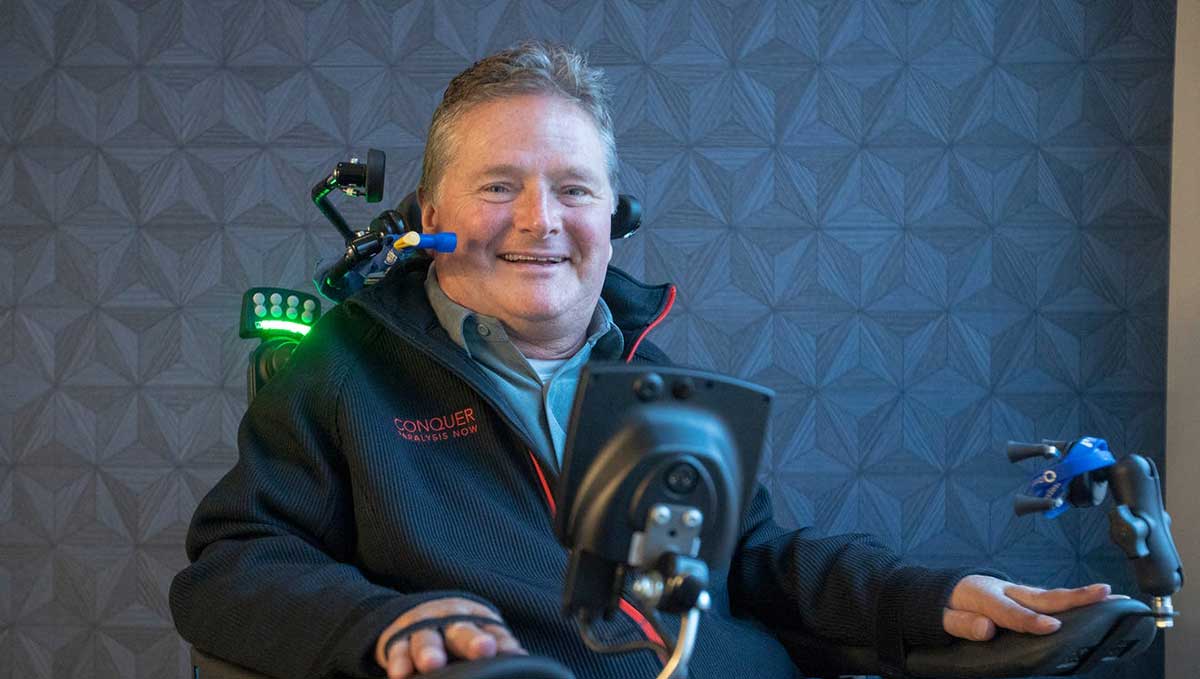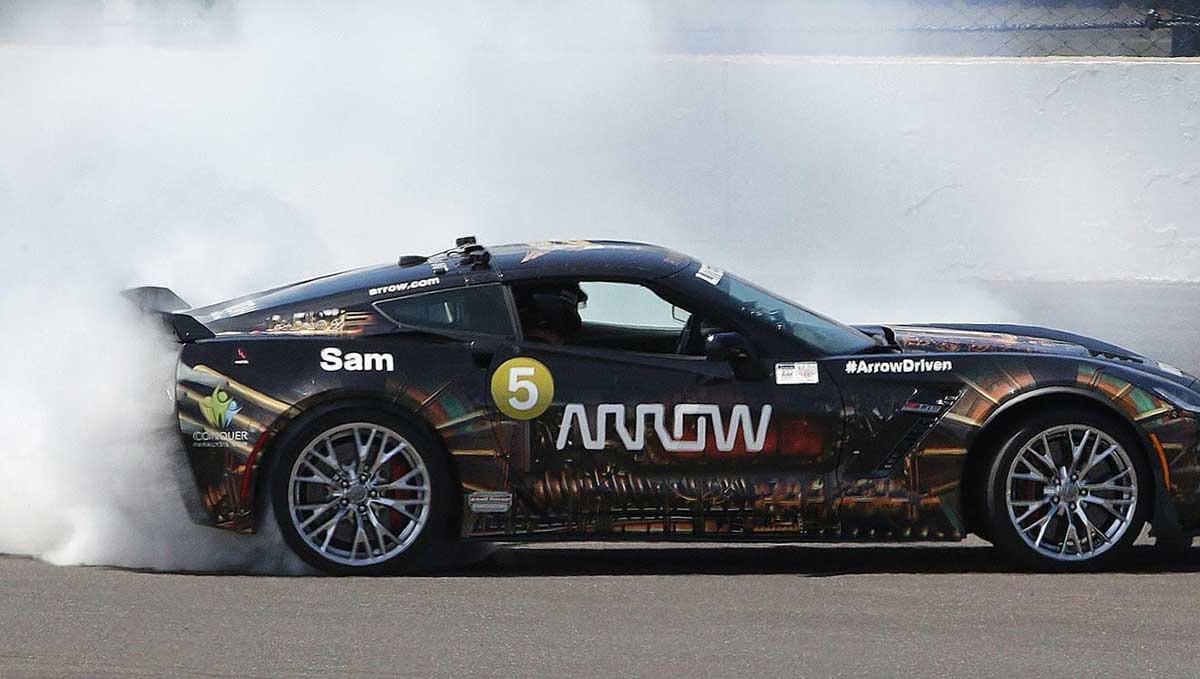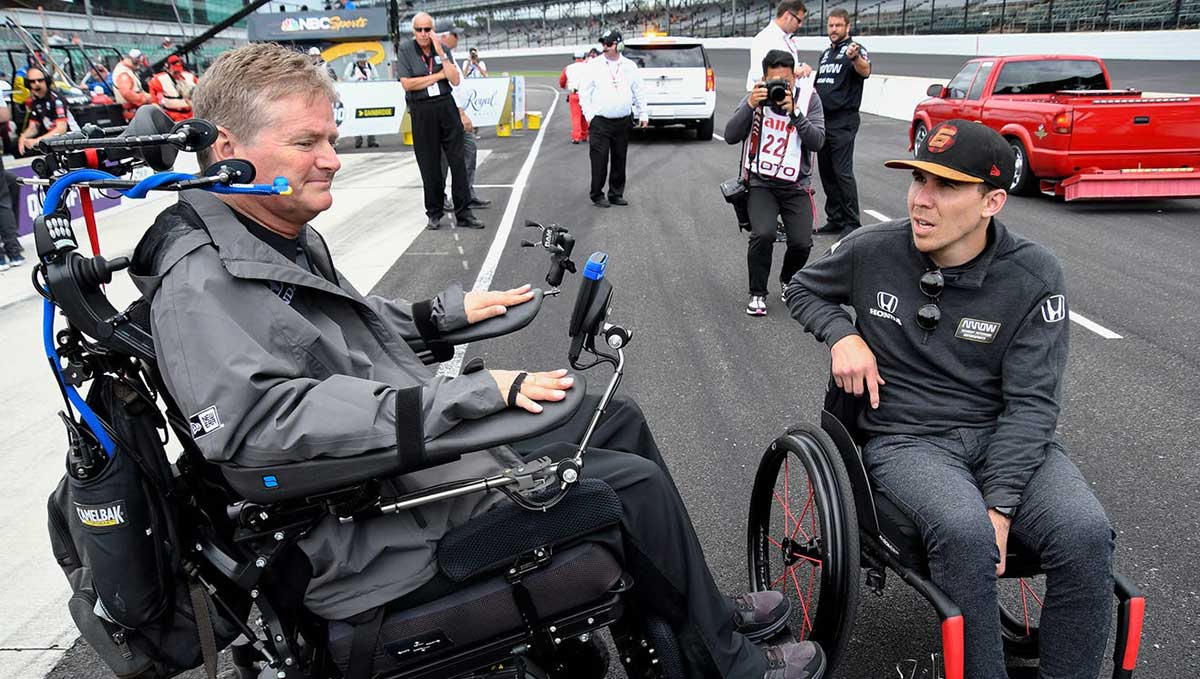
Sam Schmidt, who was injured during an IndyCar crash in 2000, seen at BraunAbility in Carmel, Thursday, Dec. 12, 2019. Schmidt serves on the board of the company, which makes wheelchair vans and wheelchair lifts.
(October 8, 2020) – First, it was two weeks on a ventilator then six months of intense physical therapy. All that time, Sam Schmidt was using every ounce of energy and will to prove wrong the doctors who said the 35-year-old open-wheel driver might not live to 40.
After a near-deadly crash during a test day for the IRL on Jan. 6, 2000 at Walt Disney World Speedway, Schmidt just wanted his life back – or some semblance of it. He never dreamed he’d return to a car again – certainly not competitively.
But he says now: Think back 20 years ago to your own life. Could you have imagined what a wireless phone or your computer or the internet would be able to do in 2020?
“(Arrow Electronics), they have a company initiative that starts at the top, and it says, ‘Technology is in the world to make people’s lives easier,’ and when you do that, with people with disabilities, it goes so far as to save their lives,” Schmidt told IndyStar in an exclusive interview this week. “It makes them more independent and makes your life psychologically better, because you can do things for yourself.
“And when it comes down to it, I was a racer. I think I always will be.”
This weekend, Schmidt will be the newest auto-racing rookie in Bowling Green, Ky., where he’ll strap into a modified Chevy Corvette C8 for the Optima Ultimate Street Car Challenge at NCM Motorsports Park. The two-day race weekend marks the first time Schmidt, who’s a quadriplegic, has entered a race since his crash more than 20 years ago.
The weekend is just the latest step in his partnership with Arrow, which began with a simple text message in 2014. Officials with the tech company reached out to Schmidt, asking about his interest in their semi-autonomous race car project. Within seconds, he responded, “If you build it, I will drive it.
Moments later, he followed up, “If we don’t go at least 100 mph, don’t call me back.”
The massive experiment that for years has melded Schmidt’s race team and partnership with Arrow, took its first step later that year with the debut of the SAM car on Pole Day at the Indianapolis 500, where the former (and soon to be present-day) racer turned laps around the Racing Capital of the World at 150 mph.
Then, in 2017, he raced IndyCar legend Mario Andretti in the modified Corvette. It used head tilt and biting sensors to steer, accelerate and brake the car around the 2.5-mile oval. Schmidt took runner-up, but capped the day with donuts all around the track and a kiss on the top of the head from Andretti himself. The IndyCar team owner had already sped up Pikes Peak the year before, another monumental step in his road back toward some sort of familiarity to what his life in the IRL once was.

Sam Schmidt executes a celebratory doughnut in his semi-autonomous car after racing Mario Andretti at Indianapolis Motor Speedway in 2017
“I figured, ‘Okay, we’re done. They got their 300 million impressions online and great return on investment,’ but they said, ‘No, what do you want to do next?’” Schmidt said. “They always kept coming back and asking that.”
Nearly 18 months ago, Schmidt, a Las Vegas resident, took in another traveling street car festival locally and spoke with coach Robby Unser about the prospect of taking one of Arrow’s modified Corvettes into a race weekend. The timing never worked out. Then earlier this year, with the IndyCar schedule more-or-less in place after its series of revisions, Oct. 10-11 just happened to be available.
The essence of the car had already been tested. So Arrow Electronics and Schmidt’s Arrow McLaren SP IndyCar team worked to ready it for a weekend-long competition against nearly 100 street legal race car drivers. Schmidt will steer this car using sensors on a headset that connect to infrared cameras mounted on the dashboard to detect his head motions. A sip-and-puff device allows him to accelerate and brake using just his breath.
The weekend is largely centered on two types of competition: Saturday’s auto-cross, which allows all 100 drivers two four-hour windows to complete as many as eight runs on a course lined with cones. One lap, depending on the course, should take 30-40 seconds. Drivers run the course until they reach their limit and enter their best time into the scoring system.
Sunday’s road course event involves a longer track and a certain number of laps, where portions of the field run the course together in heats, although a driver’s total time on the course to complete the number of laps is all that matters. Those two finishes are combined into a scoring system that determines the finishing order.
Make no mistake, Schmidt isn’t there merely to drive a car this weekend. He’s been able to do that for years.
“I’m not banging door handles, but you’re still competing head-to-head, and no one else in the field will have a disability, and that’ll make it even funner,” he said. “I don’t really want to race 100 people that have disabilities. I want to put myself up against anybody at any time.
“It’s almost like a true throwback weekend. I’m the driver. I tell them what I want, show up and drive the car, which is a great luxury. I don’t have to coordinate the parts or people or pieces, or even pay for it. They do it all.”
Schmidt said, through his analysis of the course, he expects to reach speeds up to 150 or 160 mph on the straights, matching what he’s turned on the IMS oval. He’s reached 192 mph in recent years on an Air Force base outside Las Vegas, just running at straight-line speeds, but this weekend is completely different.
He says he’s been putting in just as much time in the gym as his drivers, switching between days on the bike and in the gym working on his aerobic fitness, similar to what AMSP driver Robert Wickens has gone through in his quest to return to racing following a crash at Pocono in 2018 nearly left him paralyzed.

IndyCar team owner Sam Schmidt talks with Robert Wickens on Bump Day at the Indianapolis Motor Speedway on Sunday, May 19, 2019.
In all, it’s left Schmidt feeling like a rookie again, taking him back to 1996 in the IRL with a mix of nerves, excitement and uncertainty of what the weekend will bring. But Schmidt knows one thing already.In all, it’s left Schmidt feeling like a rookie again, taking him back to 1996 in the IRL with a mix of nerves, excitement and uncertainty of what the weekend will bring. But Schmidt knows one thing already.
“I don’t have any real expectations beyond this weekend, but I’m confident they’ll think of something crazy to do beyond this,” Schmidt said with a chuckle. “It wasn’t until 2016 or 2017 when I really thought this could be something we could race. And this is a true test of myself and this technology, to race cold-turkey, head-to-head with equal equipment to other drivers. And it’s a lot of fun when you beat them in that scenario.”
Original article by indystar.com







